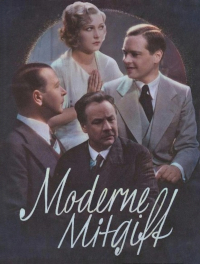
Original Title: Moderne Mitgift. (Musik muß sein!) Comedy 1932; 83 min.; Director: Emerich W. Emo; Cast: Martha Eggerth, Hans Brausewetter, Georg Alexander, Leo Slezak, Trude Berliner, Erich Kestin, Hermann Blaß, Theo Lingen, Hans Hermann Schaufuß; T.K.-Hisa-Tobis-Klangfilm.
A German engineer, while on a pleasure trip, marries a Scottish woman who is passionate about music, while he only wants to talk about cars. As a result, a music-obsessed idler and a female chauffeur pose a threat to the young marriage. However, the Scottish uncle, whose wedding gift also caused complications, manages to restore harmony.
Summary
Fred and Evelyne have gotten married. The young couple is too in love to determine if they are a good match for each other. Fred is interested in cars, while Evelyne is more into music. For now, the difference in tastes doesn’t bother them. However, as the initial infatuation fades, the character difference becomes noticeable. When Fred meets Molly Braun, an actress who knows as much about engines as he does, during a car collision, he becomes infatuated with his new acquaintance. Similarly, Evelyne finds a kindred spirit in Georg Helmbach. The marriage seems to be falling apart. A complicated pearl affair, involving an uncle of the couple, further complicates the matter, and in the end, the adventure of the two spouses almost turns into a genuine—albeit comical—criminal drama. But in the end, the uncle manages to sort everything out and bring the right couples back together.
Georg Herzberg’s review in Film Kurier No. 205 (August 31, 1932)
Yesterday, there was a great deal of joy surrounding this film that derives its events from the timeless theme of marital ups and downs. When a couple realizes, after the initial honeymoon bliss, that they are not compatible in many ways, they should not hastily seek legal intervention, but rather mend their bond through mutual concessions. In the case of this story, it entails the husband learning to play the piano and the wife learning to drive a car. Credit must be given to the author B. E. Lüthge for introducing the character of the stingy Scotsman, a figure that has been a source of amusement in comedy publications for years. This addition breathes new life into events that have been seen eighty-two times before. Furthermore, the marvelous portrayal of this Scotsman by the talented Leo Slezak, who sings and grumbles his way through the role, has already paved a significant path towards success through the portrayal of this well-chosen lead character.
Director E. W. Emo skillfully extracts every subtle hint from the screenplay provided by B. E. Lüthge, employing solid means to bring the story to life. Hans Brausewetter and Martha Eggerth embody two exceedingly likable young individuals who practically champion whirlwind romances, and their eventual return to rationality is met with applause from all sides. Brausewetter strikes an excellent tone in his role as a fresh, adventurous, and stubborn young man, and his successful portrayal as a car workshop owner is entirely believable. Finally, we have a film character with a visible and relatable profession. Eggerth, on the other hand, presents herself as pleasant, blonde, self-confident, and headstrong. The challenges that test their marriage lurk in the background, including the presence of Mr. Georg Alexander, a polished, musical, gallant man without a profession. His enchanting flirtations, however, yield the same lack of success as Trude Berliner’s attempts to captivate the husband with amusing conversations about mileage, fuel mixtures, and driving in general. In the end, Trude Berliner finds herself with the bachelor. Best of luck to them.
Adding to the humor are several other characters, such as Erich Kestin, who portrays a self-sacrificing factotum always well-intentioned but often misguided. Theo Lingen splendidly caricatures the widely known archetype of a salesman who has misunderstood all lectures and manuals on individual customer treatment, bombarding us with clichés when we are in a hurry and seeking straightforward information. Hermann Blaß delivers a few memorable scenes as well. The technical aspects of the T.K. production work seamlessly, thanks to the excellent cinematography by Otto Kanturek and Bruno Timm. Hunte and Hasler’s contributions to the film’s set design are noteworthy—I would commission them to decorate my own apartment if circumstances allowed. The sound, masterfully handled by Carlo Paganini, complements the overall experience. The fluid music, particularly the delightful Slezak song, was composed by Hans May, with lyrics penned by Fritz Rotter.
Now, the curious reader may wonder about the meaning behind the film’s title, Moderne Mitgift. Well, it revolves around the aforementioned Scotsman, who makes a grand gesture with his wedding gift—a pearl necklace. Unfortunately, upon closer examination, it turns out to be nothing more than cheap imitation. However, at certain points in the plot, it becomes genuine, setting off a series of marital catastrophes. It then reverts to imitation before once again becoming genuine. As for how it ultimately ends up, the author may or may not provide an answer. The film’s premiere at Paramount was a resounding success, and prior to the screening, Georg Alexander actively worked to set the mood for the audience. The result was an enthusiastic reception, with plenty of applause and an energetic atmosphere throughout the premiere.